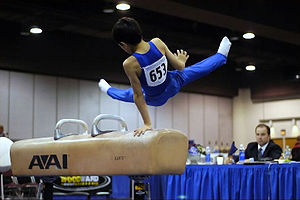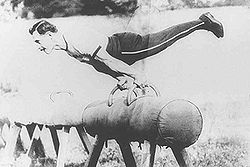
Pommel horse
Encyclopedia

Artistic gymnastics
Artistic gymnastics is a discipline of gymnastics where gymnasts perform short routines on different apparatus, with less time for vaulting . The sport is governed by the Federation Internationale de Gymnastique , which designs the Code of Points and regulates all aspects of international elite...
apparatus. Traditionally, it is used by only male
Male
Male refers to the biological sex of an organism, or part of an organism, which produces small mobile gametes, called spermatozoa. Each spermatozoon can fuse with a larger female gamete or ovum, in the process of fertilization...
gymnast
Gymnast
Gymnasts are people who participate in the sports of either artistic gymnastics, trampolining, or rhythmic gymnastics.See gymnasium for the origin of the word gymnast from gymnastikos.-Female artistic:Australia...
s. Originally made of a metal
Metal
A metal , is an element, compound, or alloy that is a good conductor of both electricity and heat. Metals are usually malleable and shiny, that is they reflect most of incident light...
frame with a wood
Wood
Wood is a hard, fibrous tissue found in many trees. It has been used for hundreds of thousands of years for both fuel and as a construction material. It is an organic material, a natural composite of cellulose fibers embedded in a matrix of lignin which resists compression...
en body and a leather
Leather
Leather is a durable and flexible material created via the tanning of putrescible animal rawhide and skin, primarily cattlehide. It can be produced through different manufacturing processes, ranging from cottage industry to heavy industry.-Forms:...
cover, modern pommel horses have a metal body covered with foam rubber and leather, with plastic handles (or pommels).
History
The pommel horse was developed centuries ago as an artificial horse used by soldiers to practice mounting and dismounting. Even Alexander the Great is believed to have used one.Dimensions
Measurements of the apparatus are published by the Fédération Internationale de GymnastiqueFédération Internationale de Gymnastique
The Fédération Internationale de Gymnastique or International Federation of Gymnastics is the governing body of competitive gymnastics. Its headquarters is in Lausanne, Switzerland. It was founded on July 23, 1881 in Liège, Belgium, making it the oldest international sport organisation...
(FIG) in the Apparatus Norms brochure.
- Height from top surface to floor: 115 centimetres (3.8 ft) ± 1 centimetre (0.393700787401575 in)
- Length at top: 160 centimetres (5.2 ft) ± 1 centimetre (0.393700787401575 in)
- Length at bottom: 155 centimetres (5.1 ft) ± 1 centimetre (0.393700787401575 in)
- Width at top: 35 centimetres (13.8 in) ± 1 centimetre (0.393700787401575 in)
- Width at bottom: 30 centimetres (11.8 in) ± 1 centimetre (0.393700787401575 in)
- Height of the pommels: 12 centimetres (4.7 in) ± 0.5 centimetre (0.196850393700787 in)
- Distance between the pommels: 40 centimetres (15.7 in) - 45 centimetres (17.7 in) (adjustable)
Routines

Code of Points (artistic gymnastics)
A Code of Points is a rulebook that defines the scoring system for each level of competition in gymnastics. There is no unified, international code of points; every oversight organization—such as FIG , NCAA Gymnastics, and most national gymnastics federations—designs and employs its own unique Code...
.
Pommel horse is considered one of the more difficult men's events. While it is well noted that all events require a certain build of muscle and technique, pommel horse tends to favor technique over muscle. This is because horse routines are done from the shoulders in a leaning motion and that no moves need to be held unlike other events. Therefore, stress induced in one's arms is reduced meaning less muscle is needed in this event than events like still rings
Rings (gymnastics)
The rings, also known as still rings , is an artistic gymnastics apparatus and the event that uses it. It is traditionally used only by male gymnasts, due to its extreme upper-body strength requirements...
or parallel bars.
International level routines

- I. Single leg swings and scissors
- II. Circles and flairs, with and/or without spindles and handstands
- III. Side and cross support travels
- IV. Kehrswings, wendeswings, flops and combined elements
- V. Dismounts
Scoring and Rules
As with all events in the Fédération Internationale de GymnastiqueFédération Internationale de Gymnastique
The Fédération Internationale de Gymnastique or International Federation of Gymnastics is the governing body of competitive gymnastics. Its headquarters is in Lausanne, Switzerland. It was founded on July 23, 1881 in Liège, Belgium, making it the oldest international sport organisation...
guidelines, form is crucial to any successful routine. For pommel horse, form consists of keeping one's feet pointed and legs straight during the entire routine. The gymnast should keep his legs together during all elements, exceptions beings scissors, single legged elements, and flairs. Gymnasts are also deducted for not passing through handstand in dismount, not using all three sections of the horse, and pausing or stopping on the apparatus. Deductions also apply for brushing and hitting the apparatus.

